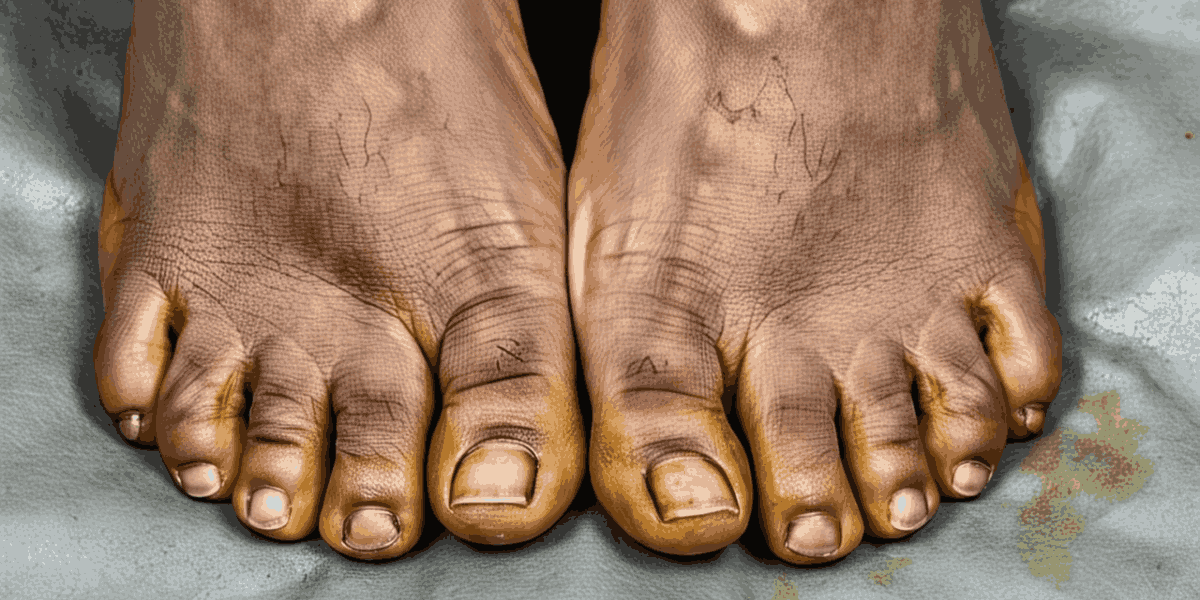If you’ve noticed discoloration on feet and ankles, you’re not alone. This common issue often signals something deeper than just a cosmetic concern. Many people dismiss it until symptoms like ankle swelling, itchy discolored ankles, or visible veins on ankles appear. These signs might point to venous insufficiency, a condition where blood struggles to return to the heart, leading to blood pooling and skin darkening due to poor circulation. Left untreated, it can result in serious complications like ulcers or infections. Understanding the causes and treatments of foot and ankle discoloration is the first step toward healthier legs and better overall vascular health.
Understanding discoloration on feet and ankles
Ankle discoloration happens when the skin around your ankle changes color. It may look red, brown, purple, or even black in severe cases. This change is usually a warning sign from your body that something isn’t right with your vascular health. It may mean there’s poor circulation in legs or damage to the veins.
In the USA, more people are noticing these changes, especially older adults. Conditions like venous insufficiency, where blood doesn’t flow properly back to the heart, often cause lower leg discoloration. When blood pools in the veins, it can damage skin tissue, leading to skin darkening due to poor circulation.
Causes of Ankle Discoloration
Several medical problems can lead to brown skin around ankles. One common issue is chronic venous disease, a condition where your veins struggle to send blood back up to your heart. This can cause visible veins on ankles, ankle swelling, and redness.
In other cases, leg vein problems like venous reflux or vascular disease symptoms can trigger skin changes. These issues happen when valves in the veins become weak or damaged. As blood backs up, it creates pressure and leads to itchy discolored ankles, which may worsen over time if not treated.
How Vein Disease Causes Ankle Discoloration
When you have venous insufficiency, your veins can’t move blood efficiently. This creates high pressure in the lower legs. Over time, this pressure breaks down the small blood vessels near your skin.
This causes iron from red blood cells to leak into surrounding tissues. The skin then turns brown due to iron buildup. This is why skin changes from vein disease often include red spots on lower legs or patches that look bruised. These areas can become inflamed, dry, or itchy, leading to more discomfort.
What is Stasis Dermatitis?
Stasis dermatitis is a skin condition caused by chronic venous disease. It makes the skin thin, flaky, and discolored. People may notice foot and ankle skin conditions like redness, swelling, and itching.
Often found in older adults, this condition gets worse without treatment. If left alone, it may cause slow healing leg wounds or ulcers. These venous eczema symptoms need quick care to avoid severe problems like infections or permanent skin damage.
Diagnosis of Ankle Discoloration
Doctors in the USA use different tests to find the cause of ankle discoloration. The first step is a physical exam where they check your legs and veins. Then, they may perform ultrasound vein mapping. This shows how blood flows through your veins and helps find blocked or weak areas.
They may also ask about your symptoms, such as leg ulcer prevention habits or how long you’ve had swelling. Knowing whether you’ve had vascular disease symptoms before can help with a faster diagnosis.
Treatment for Ankle & Lower Leg Discoloration
The first step in treating lower leg discoloration is improving circulation. Wearing special stockings called compression therapy helps blood flow more efficiently. This reduces pressure in your veins and improves skin color.
Doctors might also suggest skin care for foot and ankle skin conditions. Creams can reduce itching and prevent dryness. For people with treatment for venous stasis ulcers, medical care may include wound cleaning and antibiotics to prevent infection.

Minimally Invasive Vein Treatments
If conservative treatments don’t work, you may need minimally invasive vein procedures. One option is endovenous ablation. This procedure uses heat to close off damaged veins, stopping venous reflux.
Another option is radiofrequency vein treatment. It also targets faulty veins and seals them shut, which helps prevent blood from pooling. These modern vein treatment options are done in clinics and offer fast recovery, especially in the USA where they’re widely available.
Lifestyle Changes for Prevention
Preventing ankle swelling and visible veins on ankles starts with a healthy lifestyle. Walking often, keeping your legs elevated, and staying hydrated all help. These habits improve vascular health USA and lower your risk of vascular disease symptoms.
Avoid standing or sitting for long periods. If your job requires it, take breaks to move around. These changes support leg ulcer prevention and improve circulation, which reduces your chance of getting brown skin around ankles.
When to See a Vein Specialist
You should visit a vein specialist USA if your symptoms don’t improve with basic care. Signs like itchy discolored ankles, red spots on lower legs, or skin dark ankles poor circulation may mean your condition is serious.
If you’ve tried compression therapy and still notice pain or lower leg discoloration, it’s time to get help. A specialist can suggest advanced treatments like ultrasound vein mapping or endovenous ablation.
Peroxide kills nail fungus | Does Hydrogen Peroxide Help with Toenail Fungus?
Final Thoughts
Ankle discoloration isn’t just a cosmetic issue. It can be a sign of chronic venous disease, stasis dermatitis, or venous insufficiency. Thankfully, there are many options to treat and reverse it. From lifestyle changes to minimally invasive vein procedures, the right care can restore your skin and health.
In the USA, people have access to some of the best vein treatment options. If you’re dealing with foot and ankle skin conditions, don’t wait. Speak to a vein specialist USA today and take the first step toward healthy, even-toned skin.
FAQs
Is ankle discoloration serious?
Yes, ankle discoloration can be serious as it may signal venous insufficiency or poor circulation that requires medical care.
How do I get rid of dark feet and ankles?
Treatment involves improving blood flow, using compression therapy, skincare, and in some cases, vein procedures.
How serious is hemosiderin staining?
Hemosiderin staining isn’t dangerous itself, but it often points to chronic venous disease, which can worsen without treatment.
What does discoloration on your feet mean?
Discoloration on feet may indicate vascular issues, venous eczema, or skin changes from vein disease needing professional attention.
Q: What causes brown skin discoloration on ankles?
A: Brown discoloration on the ankles is often caused by poor circulation, venous stasis, or skin conditions like eczema or post-inflammatory hyperpigmentation. It can also result from diabetes, injury, or long-term swelling.
Welcome to Heel Tooth! I’m Lee Marvin.

